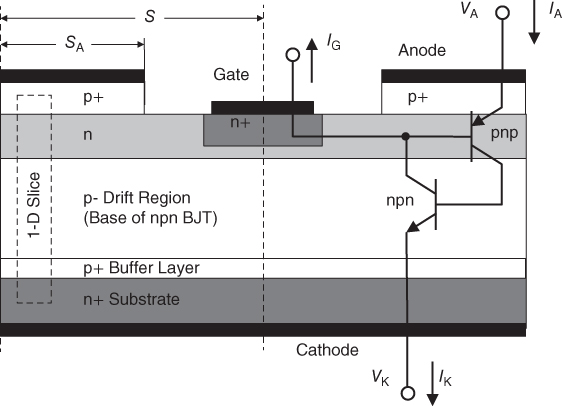9.3 Thyristors
The final power device to be considered is the pnpn thyristor. The thyristor is a four-layer, three-junction power switch that can be thought of as two merged bipolar transistors, as illustrated in Figure 9.27. The pnp BJT has a narrow base, and its emitter serves as the anode. The npn BJT has a wide, lightly-doped base, and its emitter acts as the cathode. The base of the pnp BJT is provided with an external contact called the gate, whose purpose will be described below. SiC thyristors are typically fabricated on ![]() substrates because of the high resistance of
substrates because of the high resistance of ![]() substrates.
substrates.

Figure 9.27 Cross-section of a pnpn thyristor with a  buffer layer to prevent punch-through in the blocking state. The dashed box identifies a one-dimensional slice that will be used for analysis.
buffer layer to prevent punch-through in the blocking state. The dashed box identifies a one-dimensional slice that will be used for analysis.
As seen in Figure 9.27, the collector of the pnp BJT is the base of the npn BJT, and the collector of the npn is the base of the pnp. Consequently, when both BJTs are conducting there is no need to supply external base current, since the collector of each BJT supplies base current to the other BJT, and ...
Get Fundamentals of Silicon Carbide Technology: Growth, Characterization, Devices and Applications now with the O’Reilly learning platform.
O’Reilly members experience books, live events, courses curated by job role, and more from O’Reilly and nearly 200 top publishers.

